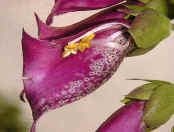The Ranger's Puzzle Page


| Here is one of my selection of puzzles based on the Natural World topics, which I talk about at the Woodland Education Centre. Wow, there's even a "Ranger's Bad Joke" at the bottom of the page! Before you start you can find out about how Foxgloves and pollination by reading the article below. |
All the answers are in the article. Print out the page and have fun!
|
Foxglove flowers are adapted to be pollinated
by insects. The Bumble Bee is the main pollinator of foxgloves. (You can find out about
pollination and about flower structure here). Left. A section cut through a Foxglove flower to show the layout of the male and female parts |
If you look at a Foxglove very carefully you can see how the process of evolution has resulted in a number of adaptations to the Foxglove so that it can attract insects such as Bumble Bees. These adaptations or modifications mean that the plant can attract the right type of insect so that the flowers can be pollinated. Pollination is essential if plants are to produce seed. If the flowers are not pollinated, the ovary which is contained in each flower is not fertilized. Seeds can not be produced unless fertilization has taken place. Of course before the Bumble Bee lands on the flower, it has to find it. This is made easy for the insect as the Foxglove produces many flowers on a tall stalk. Often many Foxgloves grow near each other and this results in a highly visible display of colour. It is no accident that the flowers are purple as Bumble Bees which are the main pollinators are particularly attracted to this colour. Insects visit the flowers for rewards. In most cases, the reward is nectar produced in the base of the flower. The actual flower of the Foxglove has a number of physical modifications. These ensure that once the Bumble Bee has found the a foxglove which is in flower, it is able to land and get the nectar. In so doing the plant has evolved a fail safe method of transferring the pollen on to the insect. When the next flower is visited the pollen rubs off on the female part of the foxglove flower. Let's take a closer look at some of the adaptations. To make it easier for a Bumble Bee to land on the flower the Foxglove has evolved a wide open mouth and a large lip to aid landing. A number of spots are present on the landing stage which help the insect to identify where to land. These spots then lead through the main part of the flower to the nectar. The mouth is bell shaped and this helps to close the bee's wings as it enters the flower. The main part of the flower is tunnel shaped and the reproductive parts of the flower are located in the roof the tunnel. A large insect like a Bumble Bee can only just squeeze along the tunnel. This means that as it travels along, the pollen which is on the stamen is brushed against the back of the bee. If the bee has already visited another foxglove then the pollen from that flower is brushes off onto the stigma pollinating it. Of course other insects are attracted to the flower and some of them are much smaller than the Bumble Bee. In order to deter them, the landing area is covered with fine hairs called guard hairs which act as a physical deterrent. Smaller insects are undesirable because they would be able to take the nectar without brushing against the flowers reproductive parts. Sometimes the weather is cold and wet during the flowering period. This means that insects are far less active. To ensure that the plant can reproduce successfully it produces many flowers on its long stalk. These do not open at the same time. The flowers at the bottom open first. It will be some weeks before all the flowers all the way to the top of the stalk have opened. This means that flowering takes place over a long time and therefore some will be open during the right weather conditions. This adaptation is therefore security against cold or wet periods when insects are less abundant. There is another advantage to flowering from the bottom of the stalk to the top. These top most flowers will still be visible above other vegetation which has grown up over the summer period. As Foxgloves are pioneer species, that is they readily colonise open areas, this is important as grasses and ultimately brambles will colonise the area. Plants which can not grow above these species will not survive. Once the Bumble Bee has unwittingly transferred the pollen to a stigma, a pollen tube germinates. It then grows down the style of the flower and into the ovary. Fertilization takes place and seed production starts. When the seeds have grown to maturity, the ovary dries and opens, allowing the small, light, seeds to be carried in the wind. The plant's tall, thin, flexible, stalk is easily blown about in the wind and this also helps to launch the seeds.
|
|
|
|||||||||||||||||||
NEW! Click Here for the new interactive version of this crossword! |
Word Search
Find the Key Words listed below in the word search box. The words may be
spelt out in
normally in a line, diagonally or even backwards! Put a line through each one as you find
it.
|
|
||||||||||||||||||||||||||||||||||||||||||||||||||||||||||||||||||||||||||||||||||||||||||||||||||||||||||||||||||||||||||||||||||||||||||||||||||||||||||||||||||||||||||||||||||||
| Ranger's Bad Joke! Why was the boxing match between the sly fox and the silly sheep abandoned? |
 |
| Answer | |
| Ranger's Puzzle Page created by Alan
Crofts, Countryside Ranger Copyright © Offwell Woodland & Wildlife Trust Website http://www.go.to/offwell |
PRODUCED BY THE OFFWELL WOODLAND & WILDLIFE TRUST WITH THE SUPPORT OF THE HERITAGE LOTTERY FUND


